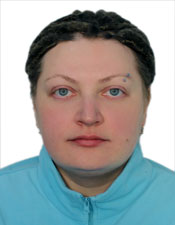
Étudiante au doctorat en sciences forestières à l'Institut de recherche forestière du Centre de recherche carélien FRI de KarRC et au doctorat sur mesure en écologie forestière à l'UQAT.
Formation académique
- Diplôme d'Ingénieur en foresterie
- Diplôme d'études supérieures dans la spécialité scientifique « Science forestière, sylviculture, gestion forestière et inventaire forestier »
Projet de recherche : Histoire et facteurs de feux de forêt boréale sous climat continental.
Nina Ryzhkova. Histoire des feux dans les forêts circumboréales :Interaction entre l'activité humaine et la variabilité climatique dans la formation des régimes de feu boréaux 2025. Thèse de doctorat en sciences de l'Environnement, Université du Québec en Abitibi-Témiscamingue. 156
Nina Ryzhkova, Hugo Asselin, Adam A. Ali, Alexander Kryshen, Yves Bergeron, Daniela Robles, Sara Pineda-Zapata, Igor Drobyshev. PDO Dynamics Shape the Fire Regime of Boreal Subarctic Landscapes in the Northwest Territories, Canada 2025. Journal of Geophysical Research: Biogeosciences e2024JG008178
DOI : 10.1029/2024JG008178
Igor Drobyshev, Yves Bergeron, Nina Ryzhkova, Alexander Kryshen. A note on the relationship between Scandinavian forest fire activity and the proxies of the Labrador Sea ice cover. 2022. Forests 13(1):60
DOI : 10.3390/f13010060
Nina Ryzhkova, Alexander Kryshen, Mats Niklasson, Guilherme Pinto, A. Aleinikov, I. Kutyavin, Yves Bergeron, Adam A. Ali, Igor Drobyshev. Climate drove the fire cycle and humans influenced fire
occurrence in the East European boreal forest. 2022. Ecological Monographs 92(4): e1530
DOI : 10.1002/ecm.1530
A. Zhukov, Mats Niklasson, Nina Ryzhkova, I. Mullonen, Guilherme Pinto, Alexander Kryshen, Igor Drobyshev. Marginal imprint of human land use upon fire history in a mire-dominated boreal landscape of the Veps Highland, North-West Russia. 2022. For. Ecol. Manage. 507:120007
DOI : 10.1016/j.foreco.2022.120007
Igor Drobyshev, Yves Bergeron, Nina Ryzhkova, Alexander Kryshen. Scandinavian Forest Fire Activity Correlates with Proxies of the
Baffin Bay Ice Cover. 2022. Forests 13:60
DOI : 10.3390/f13010060
Nina Ryzhkova, Alexander Kryshen, Zhou Wang, Jingye Li, Victor Voronin, Yves Bergeron, Rui Li, Jian-Guo Huang, Igor Drobyshev. 352 years long fire history of a Siberian boreal forest and its primary driving factor 2021. Global and Planetary Change 207:103653
DOI : 10.1016/j.gloplacha.2021.103653
Nina Ryzhkova, Mara Kitenberga, Jonathan Eden, Guilherme Pinto, Henrik Lindberg, Folmer Krikken, Maxim Yermokhin, Yves Bergeron, Alexander Kryshen, Igor Drobyshev. Trends and patterns in annually burned forest areas and fire weather across the European boreal zone in the 20th and early 21st centuries 2021. Agric. For. Meteorol. 306:108467
DOI : 10.1016/j.agrformet.2021.108467
Chéïma Barhoumi , Adam A. Ali, Odile Peyron , L Dugergil , O Borisova , G Subetto , Alexander Kryshen, Igor Drobyshev, Nina Ryzhkova. Did long-term fire control the coniferous boreal forest composition of northern Ural region 2020. J. of Biogeography 2426-2441
DOI : 10.1111/jbi.13922
Guilherme Pinto, Mats Niklasson, Nina Ryzhkova, Igor Drobyshev. A 500-year history of forest fires in Sala area, central Sweden, shows the earliest known onset of fire suppression in Scandinavia 2020. Oikos 20:130
DOI : https://doi.org/10.1007/s10113-020-01718-2
Igor Drobyshev, Mats Niklasson, Nina Ryzhkova, Götmark Frank, Guilherme Pinto, Mats Lindbladh . Did forest fires maintain mixed oak forests in southern Scandinavia? A dendrochronological speculation 2020. For. Ecol. Manage. 482:118853
DOI : https://doi.org/10.1016/j.foreco.2020.118853
Nina Ryzhkova, Guilherme Pinto, Alexander Kryshen, Yves Bergeron, Clémentine Ols, Igor Drobyshev. Multi-century reconstruction suggests complex interactions of climate and human controls of forest fire activity in a Karelian boreal landscape, North-West Russia. 2020. For. Ecol. Manage. 459:117770
DOI : 10.1016/j.foreco.2019.117770
Nina Ryzhkova Fire history in circumboreal forests: interplay of human activity and climate variability in shaping boreal fire regimes Soutenance thèse (2025-03-12)
Nina Ryzhkova PDO dynamics shape the fire regime of boreal subarctic landscapes in the Northwest Territories, Canada. 4e rencontre annuelle du Laboratoire International de Recherche sur les Forêts Froides. Ifrane, Maroc (2024-10-23)
Nina Ryzhkova, Igor Drobyshev, Yves Bergeron. 600-year dendrochronological reconstruction suggests climate drove the fire cycle and humans might have an impact on fire occurrence in a boreal landscape of southern Komi Republic, Russia 23e colloque de la Chaire AFD. Université du Québec en Abitibi-Témiscamingue (2021-12-07)
Nina Ryzhkova Effet de la suppression des feux sur l’activité régionale de feu au Québec boréal, en Scandinavie et dans la République de Komi : y a-t-il moins de feux maintenant que dans le passé? Examen doctoral (2021-06-10)
